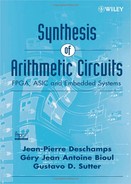2.3 FUNCTION APPROXIMATION
Numerous techniques are used to evaluate functions. According to the type of the function at hand, some evaluation methods may be more appropriate than others. For instance, a method well suited for a polynomial may not be the best for an exponential function. Polynomial approximation is most often recommended for function evaluation as any continuous function can be approximated in this way, and the implementation only consists of additions, multiplications, and powers.
Taylor and MacLaurin series are the most classic approaches to approximate functions. The series lead to precise numerical techniques to compute a function very near to one point, but precision can be lost for a bigger range of values. Trigonometric, logarithmic, and exponential function computations are typical applications.
Definition 2.19
- Taylor series. If a function f(x) has continuous derivatives up to (n + 1)th order, then this function can be expanded in the following fashion:
called a Taylor expansion at point a. Rn is called the remainder after n+1 terms. When this expansion converges over a certain range of x, that is, when
the expansion is called a Taylor series of f(x) at point a.
- MacLaurin series. If (2.10) is expressed at point a = 0, the series is called a MacLaurin series:
Examples 2.11 Taylor–MacLaurin series expansions of exponential functions:
Taylor–MacLaurin series expansions of logarithmic functions:
Taylor–MacLaurin series expansions of trigonometric functions:
where Bn are the Bernoulli numbers ([R0S2000]).
